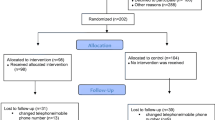Abstract
Introduction and hypothesis
The National Institute for Health and Clinical Excellence (NICE) recommends antenatal pelvic floor exercises during first pregnancy to reduce postpartum stress incontinence. The aim of this audit was to assess patient awareness and compliance with this guideline.
Methods
An anonymous self-constructed questionnaire was given to patients after their first delivery.
Results
A total of 223 questionnaires were returned over a 6-month period. Although 95% of patients were aware of the importance of pelvic floor exercises, only a limited proportion of them had the right information and a minority practised them. Printed material seemed to be very influential in getting the message across. The importance of giving information early in pregnancy and national awareness was shown in the suggestions for improvement.
Conclusions
Patient awareness and actual practise of antenatal pelvic floor exercises did not meet NICE guidelines, calling for strategies to improve awareness and adherence.
Similar content being viewed by others
References
Sampselle CM, Miller JM, Mims BL, Delancey JO, Ashton-Miller JA, Antonakos C (1998) Effect of pelvic muscle exercise on transient incontinence during pregnancy and after birth. Obstet Gynecol 91:406–412
Morkved S, Bo K, Schei B, Salvesen KA (2003) Pelvic floor muscle training during pregnancy to prevent urinary incontinence; a single-blind randomized controlled trial. Obstet Gynecol 101:313–319
National Institute for Health and Clinical Excellence (2006) Urinary incontinence: the management of urinary incontinence in women, Guideline 40. National Institute for Health and Clinical Excellence, London, UK
Bø K, Aschehoug A (2007) Strength training. In: Bø K, Berghmans B, Mørkved S, Van Kampen M (eds) Evidence-based physical therapy for the pelvic floor: bridging science and clinical practice. Churchill Livingstone Elsevier, Edinburgh, UK, pp 119–132
Bø K, Hagen RH, Kvarstein B, Jorgensen J, Larsen S (1990) Pelvic floor muscle exercises for the treatment of female stress urinary incontinence: III effects of two different degrees of pelvic muscle exercises. Neurourol Urodyn 9:489–502
Bump RC, Hurt WG, Fantl JA, Wyman JF (1991) Assessment of Kegel pelvic muscle exercise performance after brief verbal instruction. Amer J Obstet Gynecol 165:322–327
Reilly ET, Freeman RM, Waterfield MR, Waterfield AE, Steggles P, Pedlar F (2002) Prevention of postpartum stress incontinence in primigravidae with increased bladder neck mobility: a randomised controlled trial of antenatal pelvic floor exercises. BJOG 109:68–76
Agur WI, Steggles P, Waterfield M, Freeman RM (2008) The long-term effectiveness of antenatal pelvic floor muscle training: eight-year follow up of a randomised controlled trial. BJOG 115:985–990
Department of Health (2007) The pregnancy book. Central Office of Information, London, UK
Yalcin OT, Hassa H, Ozlap S, Yildirim A, Sener T (1998) Results of the anti-incontinence operations and Kegel exercises in patients with type II anatomic stress incontinence. Acta Obstet Gynecol Scand 77:341–346
Sluijs EM, Knibbe JJ (1991) Patient compliance with exercise: different theoretical approaches to short and long term compliance. Patient Educ Couns 17:191–204
Prochaska JO, DiClemente CC, Norcross JC (1992) In search of how people change: applications to addictive behaviours. Am Psychol 47:1102–1114
Alewijnse D, Mesters I, Metsemakers J, van den Borne B (2003) Predictors of long-term adherence to pelvic floor muscle exercise therapy among women with urinary incontinence. Health Educ Res 18:511–524
Bø K, Talseth T, Holme I (1999) Single blind, randomised controlled trial of pelvic floor exercises, electrical stimulation, vaginal cones, and no treatment in management of genuine stress incontinence in women. BMJ 318:487–493
Paddison K (2002) Complying with pelvic floor exercises: a literature review. Nurs Stand 16:33–38
Strecher VJ, Seijts GH, Kok GJ, Latham GP, Glasgow R, DeVellis B, Meertens RM, Bulger DW (1995) Goal setting as a strategy for health behavior change. Health Educ Q 22:190–200
Alewijnse D, Mesters I, Metsemakers J, van den Borne B (2002) Program development for promoting adherence during and after exercise therapy for urinary incontinence. Patient Educ Couns 48:147–160
Conflicts of interest
None.
Author information
Authors and Affiliations
Corresponding author
Rights and permissions
About this article
Cite this article
Ismail, S.I.M.F. An audit of NICE guidelines on antenatal pelvic floor exercises. Int Urogynecol J 20, 1417–1422 (2009). https://doi.org/10.1007/s00192-009-0967-x
Received:
Accepted:
Published:
Issue Date:
DOI: https://doi.org/10.1007/s00192-009-0967-x




